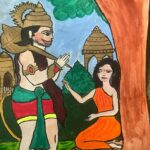This year, on October 22, we celebrate the jayanti of the great sage Aadikavi Valmiki, the composer of the epic Srimad Ramayana, who was direct proof for the transformation that can happen by chanting the Divine Rama Nama.
His Holiness Sri Sri Muralidhara Swamiji, in his kirtan, “Nama mahimayai uraithiduven keleer” (Listen to the Greatness of the Divine Name) sings about Sage Valmiki:
“alaindhu thirindhu oruvan
kolai thozilE purindhu
tAraka mandhiram japithAn allavo
nAma balathinAl AdhikAvyam saidhu
nAm ellOrum vanangum munivarum AnAn”
“Did not a wayward robber with killing as his profession persistently chant the Rama Nama? Simply due to the power of the Name that he chanted the robber was able to compose the great Ramayana, and was transformed into a revered sage.”

 Although born in the lineage of Bhrigu maharishi, fate consigned Valmiki to a family of robbers. One day the great sage Narada, while passing through the jungle, came in contact with the robber. Narada asked Valmiki whether his family, for whose sake he had taken to robbing, will partake in his sins also.
Although born in the lineage of Bhrigu maharishi, fate consigned Valmiki to a family of robbers. One day the great sage Narada, while passing through the jungle, came in contact with the robber. Narada asked Valmiki whether his family, for whose sake he had taken to robbing, will partake in his sins also.
The robber went to ask the same question to his family, but although more than willing to share his booty, none of them were willing to share his sins. So the robber went back to Sage Narada, his head hanging down.
Narada then asked him to constantly chant “Rama”. However the robber was unable to pronounce the word as he was not used to uttering sacred syllables. So Narada pointed to a tree and asked him what it was. The robber replied, “mara” (tree). Narada asked him to continue to chant “mara”, which when chanted continuously would easily make him chant “Rama”.
Following Narada’s instructions, the robber sat in a meditative posture and chanted the Name for many years, during which his body became completely covered by an anthill. When Narada came back to see him, the robber was completely transformed with no trace of his previous negative and violent tendencies. What was left was pure devotion to the Lord! He was then bestowed with the honor of a Brahmarishi and given the name Valmiki, since he was reborn from a valmikam (anthill).
Sage Valmiki founded his ashram on the banks of River Ganga and continued his life of tapas and devotion to the Lord. Once when Sage Narada visited his hermitage, Valmiki posed a question, “Who can possibly be full of virtues in this world at present, be possessed of prowess, know what is right, be conscious of services done, be truthful of speech, be firm of resolve, be possessed of right conduct, be friendly to all living beings, be a man of knowledge, be powerful yet with a singularly loveable appearance, be subdued in his Self, have conquered anger, be possessed of splendor, be above fault-finding, and whom the very Gods dread when his wrath is provoked in battle?”
“konvasmin sAmpratham loke gunavAn kascha veeryavAn …”
Narada who was highly pleased replied, “Be pleased to hear from me of such a man endowed with manifold and rare virtues, by the name of Rama, a descendant of Ikshwaku race, son of King Dasaratha…” and went on to narrate the story of Ramayana in a nutshell.
This came to be called as Samkshepa Ramayana constituting the first chapter of the epic, a foundation on which the magnificent 24,000-verse edifice was built by Valmiki.
Immersed deep into this story, Valmiki left for the river Tamasa. In the next instant he witnessed a heartless hunter mercilessly killing a male bird that was with its mate. The piteous wailing of the distressed female bird moved the heart of the sage so much that he spontaneously uttered a curse on the hunter. However, this curse came out of his mouth in the form of a sloka, a perfectly metrical composition:
mA niShAda pratiShThAn tvamagamah shAshvatIh samAh |yatkrauJNchamithunAdekamavadhIh kAmamohitam ||
“Oh! Ill-fated hunter! You shall not command any respect in society for a long time as you have shot dead one of the pair of krauncha birds indulged in passion.
When he returned to his hermitage, Lord Brahma appeared before him and said that the curse was a spontaneous outburst of his inner voice motivated by Divine will which would constitute the mangala sloka (benedictory / introductory verse) for the great epic he would compose.
‘Ma’ also refers to Mahalakshmi, ‘nishada’ means “resides in”, ‘krauncha-mithunam’ can also mean “Asura couple” ( Mandodari and Ravana). Hence this sloka is interpreted as,
“Oh! ShrinivAsa! May you attain everlasting glory since you killed Ravana who was smitten by desire for Sita”
Explaining thus, Brahma ordained Valmiki to compose an epic poem on the story of Rama in his newly discovered meter. He also gave him the boon of the visions of all the incidents. Accordingly, Valmiki composed the epic, Srimad Ramayana. No wonder as one reads every sloka with its meaning we would be able to exactly picture each scene in front of our eyes.
Ramayana was later sung by Lava and Kusha, the sons of Lord Rama and pupils of none other than Valmiki himself. In the audience was Lord Rama Himself, and it was the power of Ramayana that re-united Sita and Rama—Jagan Matha and Jagath Pitha—together!
Nithya Rajesh, Boston, MA
Illustrations: Sripriya Sarathy, Charlotte, NC







So wonderful to know, never heard this side of story. Thanks for sharing.
Very interesting. It helped me in my studies.
Hi,
I was looking for the meaning of this Shloka for quite some time and was very happy to find the same here.
Thanks ! Thanks ! Very useful ! !